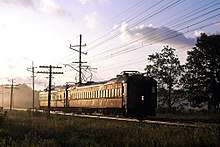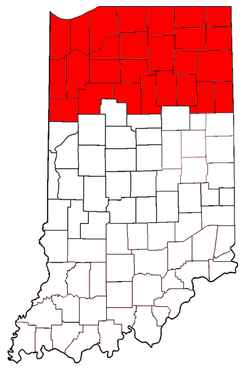South Shore Line
The South Shore Line (reporting mark NICD) is an electrically powered interurban commuter rail line operated by the Northern Indiana Commuter Transportation District (NICTD) between Millennium Station in downtown Chicago and the South Bend International Airport in South Bend, Indiana, United States. The name refers to both the physical line and the service operated over that route. The line was built in 1901–08 by predecessors of the Chicago South Shore and South Bend Railroad, which continues to operate freight service. Passenger operation was assumed by the NICTD in 1989. The South Shore Line is one of the last surviving interurban trains in the United States.
| South Shore Line | |||||||||||||||||||||||||||||||||||||||||||||||||||||||||||||||||||||||||||||||||||||||||||||||||||||||||||||||||||||||||||||||||||||||||||||||||||||||||||||||||||||||||||||||||||||||||||||||||||||||||||||||||||||||||||||||||||||||||||||||||||||||||||||||||||||||||||||||||||||||||||||||||||||||||||||||||||||||||||||||||||||||||||||||||||||||||||||||||||||||||||||||||||||||||||||||||||||||||
|---|---|---|---|---|---|---|---|---|---|---|---|---|---|---|---|---|---|---|---|---|---|---|---|---|---|---|---|---|---|---|---|---|---|---|---|---|---|---|---|---|---|---|---|---|---|---|---|---|---|---|---|---|---|---|---|---|---|---|---|---|---|---|---|---|---|---|---|---|---|---|---|---|---|---|---|---|---|---|---|---|---|---|---|---|---|---|---|---|---|---|---|---|---|---|---|---|---|---|---|---|---|---|---|---|---|---|---|---|---|---|---|---|---|---|---|---|---|---|---|---|---|---|---|---|---|---|---|---|---|---|---|---|---|---|---|---|---|---|---|---|---|---|---|---|---|---|---|---|---|---|---|---|---|---|---|---|---|---|---|---|---|---|---|---|---|---|---|---|---|---|---|---|---|---|---|---|---|---|---|---|---|---|---|---|---|---|---|---|---|---|---|---|---|---|---|---|---|---|---|---|---|---|---|---|---|---|---|---|---|---|---|---|---|---|---|---|---|---|---|---|---|---|---|---|---|---|---|---|---|---|---|---|---|---|---|---|---|---|---|---|---|---|---|---|---|---|---|---|---|---|---|---|---|---|---|---|---|---|---|---|---|---|---|---|---|---|---|---|---|---|---|---|---|---|---|---|---|---|---|---|---|---|---|---|---|---|---|---|---|---|---|---|---|---|---|---|---|---|---|---|---|---|---|---|---|---|---|---|---|---|---|---|---|---|---|---|---|---|---|---|---|---|---|---|---|---|---|---|---|---|---|---|---|---|---|---|---|---|---|---|---|---|---|---|---|---|---|---|---|---|---|---|---|---|---|---|---|---|---|---|---|---|---|---|---|---|---|---|---|---|---|---|---|---|---|---|---|---|---|---|---|---|---|---|---|---|---|---|---|---|---|---|---|
 | |||||||||||||||||||||||||||||||||||||||||||||||||||||||||||||||||||||||||||||||||||||||||||||||||||||||||||||||||||||||||||||||||||||||||||||||||||||||||||||||||||||||||||||||||||||||||||||||||||||||||||||||||||||||||||||||||||||||||||||||||||||||||||||||||||||||||||||||||||||||||||||||||||||||||||||||||||||||||||||||||||||||||||||||||||||||||||||||||||||||||||||||||||||||||||||||||||||||||
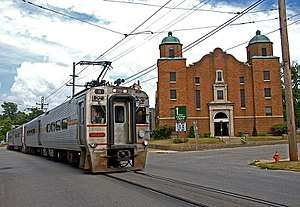 A street running South Shore Line train passes a church in Michigan City, Indiana | |||||||||||||||||||||||||||||||||||||||||||||||||||||||||||||||||||||||||||||||||||||||||||||||||||||||||||||||||||||||||||||||||||||||||||||||||||||||||||||||||||||||||||||||||||||||||||||||||||||||||||||||||||||||||||||||||||||||||||||||||||||||||||||||||||||||||||||||||||||||||||||||||||||||||||||||||||||||||||||||||||||||||||||||||||||||||||||||||||||||||||||||||||||||||||||||||||||||||
| Overview | |||||||||||||||||||||||||||||||||||||||||||||||||||||||||||||||||||||||||||||||||||||||||||||||||||||||||||||||||||||||||||||||||||||||||||||||||||||||||||||||||||||||||||||||||||||||||||||||||||||||||||||||||||||||||||||||||||||||||||||||||||||||||||||||||||||||||||||||||||||||||||||||||||||||||||||||||||||||||||||||||||||||||||||||||||||||||||||||||||||||||||||||||||||||||||||||||||||||||
| Type | Interurban Commuter rail | ||||||||||||||||||||||||||||||||||||||||||||||||||||||||||||||||||||||||||||||||||||||||||||||||||||||||||||||||||||||||||||||||||||||||||||||||||||||||||||||||||||||||||||||||||||||||||||||||||||||||||||||||||||||||||||||||||||||||||||||||||||||||||||||||||||||||||||||||||||||||||||||||||||||||||||||||||||||||||||||||||||||||||||||||||||||||||||||||||||||||||||||||||||||||||||||||||||||||
| Status | Operational | ||||||||||||||||||||||||||||||||||||||||||||||||||||||||||||||||||||||||||||||||||||||||||||||||||||||||||||||||||||||||||||||||||||||||||||||||||||||||||||||||||||||||||||||||||||||||||||||||||||||||||||||||||||||||||||||||||||||||||||||||||||||||||||||||||||||||||||||||||||||||||||||||||||||||||||||||||||||||||||||||||||||||||||||||||||||||||||||||||||||||||||||||||||||||||||||||||||||||
| Locale | Chicago, Illinois to South Bend, Indiana | ||||||||||||||||||||||||||||||||||||||||||||||||||||||||||||||||||||||||||||||||||||||||||||||||||||||||||||||||||||||||||||||||||||||||||||||||||||||||||||||||||||||||||||||||||||||||||||||||||||||||||||||||||||||||||||||||||||||||||||||||||||||||||||||||||||||||||||||||||||||||||||||||||||||||||||||||||||||||||||||||||||||||||||||||||||||||||||||||||||||||||||||||||||||||||||||||||||||||
| Termini | Millennium Station South Bend Airport | ||||||||||||||||||||||||||||||||||||||||||||||||||||||||||||||||||||||||||||||||||||||||||||||||||||||||||||||||||||||||||||||||||||||||||||||||||||||||||||||||||||||||||||||||||||||||||||||||||||||||||||||||||||||||||||||||||||||||||||||||||||||||||||||||||||||||||||||||||||||||||||||||||||||||||||||||||||||||||||||||||||||||||||||||||||||||||||||||||||||||||||||||||||||||||||||||||||||||
| Stations | 19 | ||||||||||||||||||||||||||||||||||||||||||||||||||||||||||||||||||||||||||||||||||||||||||||||||||||||||||||||||||||||||||||||||||||||||||||||||||||||||||||||||||||||||||||||||||||||||||||||||||||||||||||||||||||||||||||||||||||||||||||||||||||||||||||||||||||||||||||||||||||||||||||||||||||||||||||||||||||||||||||||||||||||||||||||||||||||||||||||||||||||||||||||||||||||||||||||||||||||||
| Services | 1 | ||||||||||||||||||||||||||||||||||||||||||||||||||||||||||||||||||||||||||||||||||||||||||||||||||||||||||||||||||||||||||||||||||||||||||||||||||||||||||||||||||||||||||||||||||||||||||||||||||||||||||||||||||||||||||||||||||||||||||||||||||||||||||||||||||||||||||||||||||||||||||||||||||||||||||||||||||||||||||||||||||||||||||||||||||||||||||||||||||||||||||||||||||||||||||||||||||||||||
| Ridership | 11,600 (weekdays)[1] 3,455,800 (2017)[2] | ||||||||||||||||||||||||||||||||||||||||||||||||||||||||||||||||||||||||||||||||||||||||||||||||||||||||||||||||||||||||||||||||||||||||||||||||||||||||||||||||||||||||||||||||||||||||||||||||||||||||||||||||||||||||||||||||||||||||||||||||||||||||||||||||||||||||||||||||||||||||||||||||||||||||||||||||||||||||||||||||||||||||||||||||||||||||||||||||||||||||||||||||||||||||||||||||||||||||
| Website | mysouthshoreline.com | ||||||||||||||||||||||||||||||||||||||||||||||||||||||||||||||||||||||||||||||||||||||||||||||||||||||||||||||||||||||||||||||||||||||||||||||||||||||||||||||||||||||||||||||||||||||||||||||||||||||||||||||||||||||||||||||||||||||||||||||||||||||||||||||||||||||||||||||||||||||||||||||||||||||||||||||||||||||||||||||||||||||||||||||||||||||||||||||||||||||||||||||||||||||||||||||||||||||||
| Operation | |||||||||||||||||||||||||||||||||||||||||||||||||||||||||||||||||||||||||||||||||||||||||||||||||||||||||||||||||||||||||||||||||||||||||||||||||||||||||||||||||||||||||||||||||||||||||||||||||||||||||||||||||||||||||||||||||||||||||||||||||||||||||||||||||||||||||||||||||||||||||||||||||||||||||||||||||||||||||||||||||||||||||||||||||||||||||||||||||||||||||||||||||||||||||||||||||||||||||
| Opened | 1903 | ||||||||||||||||||||||||||||||||||||||||||||||||||||||||||||||||||||||||||||||||||||||||||||||||||||||||||||||||||||||||||||||||||||||||||||||||||||||||||||||||||||||||||||||||||||||||||||||||||||||||||||||||||||||||||||||||||||||||||||||||||||||||||||||||||||||||||||||||||||||||||||||||||||||||||||||||||||||||||||||||||||||||||||||||||||||||||||||||||||||||||||||||||||||||||||||||||||||||
| Operator(s) | Northern Indiana Commuter Transportation District | ||||||||||||||||||||||||||||||||||||||||||||||||||||||||||||||||||||||||||||||||||||||||||||||||||||||||||||||||||||||||||||||||||||||||||||||||||||||||||||||||||||||||||||||||||||||||||||||||||||||||||||||||||||||||||||||||||||||||||||||||||||||||||||||||||||||||||||||||||||||||||||||||||||||||||||||||||||||||||||||||||||||||||||||||||||||||||||||||||||||||||||||||||||||||||||||||||||||||
| Technical | |||||||||||||||||||||||||||||||||||||||||||||||||||||||||||||||||||||||||||||||||||||||||||||||||||||||||||||||||||||||||||||||||||||||||||||||||||||||||||||||||||||||||||||||||||||||||||||||||||||||||||||||||||||||||||||||||||||||||||||||||||||||||||||||||||||||||||||||||||||||||||||||||||||||||||||||||||||||||||||||||||||||||||||||||||||||||||||||||||||||||||||||||||||||||||||||||||||||||
| Line length | 90 miles (140 km) | ||||||||||||||||||||||||||||||||||||||||||||||||||||||||||||||||||||||||||||||||||||||||||||||||||||||||||||||||||||||||||||||||||||||||||||||||||||||||||||||||||||||||||||||||||||||||||||||||||||||||||||||||||||||||||||||||||||||||||||||||||||||||||||||||||||||||||||||||||||||||||||||||||||||||||||||||||||||||||||||||||||||||||||||||||||||||||||||||||||||||||||||||||||||||||||||||||||||||
| Track gauge | 4 ft 8 1⁄2 in (1,435 mm) standard gauge | ||||||||||||||||||||||||||||||||||||||||||||||||||||||||||||||||||||||||||||||||||||||||||||||||||||||||||||||||||||||||||||||||||||||||||||||||||||||||||||||||||||||||||||||||||||||||||||||||||||||||||||||||||||||||||||||||||||||||||||||||||||||||||||||||||||||||||||||||||||||||||||||||||||||||||||||||||||||||||||||||||||||||||||||||||||||||||||||||||||||||||||||||||||||||||||||||||||||||
| Electrification | Overhead catenary, 1500 V DC | ||||||||||||||||||||||||||||||||||||||||||||||||||||||||||||||||||||||||||||||||||||||||||||||||||||||||||||||||||||||||||||||||||||||||||||||||||||||||||||||||||||||||||||||||||||||||||||||||||||||||||||||||||||||||||||||||||||||||||||||||||||||||||||||||||||||||||||||||||||||||||||||||||||||||||||||||||||||||||||||||||||||||||||||||||||||||||||||||||||||||||||||||||||||||||||||||||||||||
| |||||||||||||||||||||||||||||||||||||||||||||||||||||||||||||||||||||||||||||||||||||||||||||||||||||||||||||||||||||||||||||||||||||||||||||||||||||||||||||||||||||||||||||||||||||||||||||||||||||||||||||||||||||||||||||||||||||||||||||||||||||||||||||||||||||||||||||||||||||||||||||||||||||||||||||||||||||||||||||||||||||||||||||||||||||||||||||||||||||||||||||||||||||||||||||||||||||||||
Service
The public Monday-Friday timetable shows 20 eastbound trains operating; 18 of those operate out of Millennium Station. Of those, five terminate at Adam Benjamin Metro Center in Gary, seven at South Bend Airport, and 10 at Carroll Avenue station in Michigan City. Two daily trains begin at Carroll Avenue and continue to South Bend Airport.
Westbound, 16 trains operate, with seven originating in South Bend (including one rush-hour express to Millennium Station) and nine originating at Carroll Avenue. Of these, 14 terminate at Millennium Station, while two run from South Bend to Carroll Avenue.
History
Private operation
The South Shore Line was constructed between 1901–08 by the Chicago and Indiana Air Line Railway (reorganized as the Chicago, Lake Shore and South Bend Railway [CLS&SB] in 1904). Revenue service between Michigan City and South Bend began on July 1, 1908. The CLS&SB leased the Kensington and Eastern Railroad on April 4, 1909, giving it access to Chicago. That year the full line to Kensington on the Illinois Central was completed, and beginning on June 2, 1912, the electric cars were coupled to IC steam locomotives and run to downtown Chicago.[3]
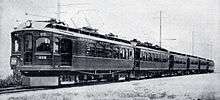
The Chicago, Lake Shore and South Bend entered bankruptcy in 1925 and was bought by Samuel Insull's Chicago South Shore and South Bend Railroad (CSS&SB).[4] The line continued to handle both freight and passengers. Under Insull, the CSS&SB embarked on a major rehabilitation program. This included new ballast and ties, 100-pound (45 kg) rail in place of 70-pound (32 kg) rail, brush clearance, and an overhaul of the line's block signals.[5] In 1946 the company acquired three Little Joe electric locomotives for freight service. These locomotives had originally been constructed for the Soviet Union, but changing attitudes due to the Cold War prevented them from being delivered. These locomotives continued in freight service on the CSS&SB until 1983. No. 803, is preserved in operating condition at the Illinois Railway Museum.
The power system was changed from 6600 volts AC to 1500 volts DC on July 28, 1926, allowing trains to operate directly to the Illinois Central Railroad's Randolph Street Terminal (now Millennium Station) without an engine change. Trains began running to Randolph Street on August 29.[6] That same year, the original line between East Chicago and Indiana Harbor was abandoned.[3]
The Chicago South Shore and South Bend turned a profit during World War II due to the industrial nature of Northern Indiana. However, highway competition and suburban growth led to ridership declines. By the 1950s all interurban lines were seeing a decline in rail travel as automobile use increased.[7] On September 16, 1956, a street running section in East Chicago was removed with the building of a new alignment alongside the Indiana Toll Road. A truncation to west of downtown South Bend removed street trackage in that city from July 1, 1970.[3]
The Chesapeake and Ohio Railway acquired the CSS&SB on January 3, 1967 and continued the operation of passenger services.[8] The Chicago South Shore and South Bend was one of six railroads with long-distance passenger services to decline joining Amtrak in 1971 and in 1976, they asked the Interstate Commerce Commission (ICC) to abandon passenger service. The ICC gave the state of Indiana a chance to reply and subsequently, the Northern Indiana Commuter Transportation District (NICTD) was formed in 1977 to subsidize service.
Public operation

In the late 1980s, the Chicago South Shore and South Bend went bankrupt and on December 29, 1989, passenger service was assumed by NICTD.[9] In December 1990, the track was sold to NICTD and freight service was taken over by the new Chicago South Shore and South Bend Railroad, a subsidiary of short line operator Anacostia & Pacific. On November 21, 1992, the line's South Bend terminus moved from the Amtrak station to the airport.[10] On July 5, 1994, NICTD closed the Ambridge, Kemil Road, Willard Avenue, LaLumiere, Rolling Prairie, and New Carlisle flag stops. A seventh station, Dune Acres, closed around the same time once parking was expanded at nearby Dune Park.[11]
The railroad began a three-year project in 2009 to replace all catenary on its line between Michigan City and Gary, some of which was nearly 90 years old. The project cost $18 million, and caused service disruptions on weekends while new wires were strung.[12]
In 2015 NICTD began an express service between South Bend and Chicago. Targeted at business travelers, the train makes just two intermediate stops: Dune Park and East Chicago. The total scheduled travel time is 1 hour 55 minutes, more than thirty minutes faster than existing services.[13]
Route
Departing South Bend Airport, the South Shore Line heads south alongside Bendix Drive, then west along Westmoor Street, before connecting with the tracks that ran to its former terminus. Between that point and Hudson Lake, Indiana, the South Shore Line runs parallel to Norfolk Southern's Chicago Line, also used by Amtrak's Lake Shore Limited and Capitol Limited, on the north side of the tracks. Just before Hudson Lake, the line crosses from St. Joseph County into LaPorte County and enters the Central Time Zone.
From Hudson Lake, the South Shore continues straight west to Michigan City. In Michigan City, the track runs down the middle of 11th street from Michigan Boulevard to Tennessee Street, where it crosses over to Tenth Street, and has an at-grade diamond with Amtrak's Michigan Services. The track then runs down Tenth Street to Sheridan Avenue on the west side of Michigan City. Leaving Michigan City, the track travels through Indiana Dunes State Park, crosses over the Chicago Line and runs parallel to it, this time on the south side, past Long Lake. At Gary, Indiana, the route heads west to service the Gary Airport, at times running parallel to the Indiana Toll Road, as far as Hammond, Indiana. Just west of the Hammond station, the route crosses into Illinois and Chicago city limits, at which point the track curves northwest, through the Hegewisch neighborhood and, after crossing the Bishop Ford Freeway and the Calumet River, converges with the Metra Electric line south of Kensington/115th Street station. The South Shore Line then runs over the Metra Electric from Kensington/115th Street the rest of the way to Millennium Station.
The line is quadruple tracked along the section shared with the Metra Electric line from Millennium Station to Kensington/115th Street, double-tracked from Kensington/115th Street to east of Gary Metro Center. From there it is single-tracked with passing sidings to South Bend Airport, save for a 6.5-mile (10.5 km) stretch of double track around Ogden Dunes and the yard at Michigan City.[14] As of 2016 NICTD is studying double-tracking an additional 25 miles (40 km) between Gary and Michigan City at an estimated cost of $210 million.[15]
Rolling stock
Current
| South Shore Line | |
|---|---|
 | |
| In service | 1982–present |
| Manufacturer | Nippon Sharyo |
| Constructed | 1982–1983, 1992, 2001 |
| Number built | 68 |
| Formation | Married-pair |
| Fleet numbers | 1–48, 201–210, 101–119 |
| Capacity | 93[16] |
| Operator(s) | CSS&SB, NICTD |
| Line(s) served | South Shore Line |
| Specifications | |
| Car body construction | stainless steel |
| Car length | 85 ft (25.91 m)[16] |
| Width | 10 ft 6 in (3.20 m)[16] |
| Height | 15 ft 11 in (4.85 m)[16] |
| Wheel diameter | 36 in (914 mm)[16] |
| Wheelbase | 8 ft 2 1⁄2 in (2.502 m)[16] |
| Maximum speed | 79 mph (127 km/h)[16] |
| Weight | 118,000 lb (54,000 kg)[16] (empty) |
| Train heating | Electric heating, Air conditioning |
| Electric system(s) | 1,500 V, DC Overhead lines |
| Current collection method | Pantograph |
| Bogies | ND-312[16] |
| Coupling system | Tomlinson |
| Track gauge | 4 ft 8 1⁄2 in (1,435 mm) standard gauge |
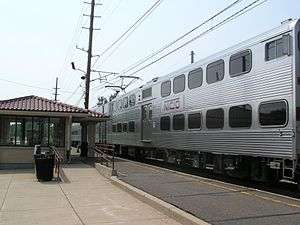
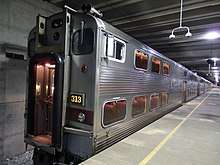
The South Shore Line operates with a fleet of 82 rail cars built between 1982–2009 by Nippon Sharyo. The fleet consists of 58 single-level self-propelled cars, 10 single-level unpowered trailers, and 14 bilevel self-propelled cars.[17] The single level fleet's design shares commonalities with MARC's locomotive-hauled MARC II fleet, which were also built by Nippon Sharyo.[18]
| Numbers | Model | Built | Builder |
|---|---|---|---|
| 1–48 | Single-level electric multiple unit | 1982–83, 1992 | Nippon Sharyo |
| 201–210 | Trailer | 1992 | Nippon Sharyo |
| 101–110 | Single-level electric multiple unit | 2001 | Nippon Sharyo |
| 301–314 | Highliner II | 2009 | Nippon Sharyo |
Retired

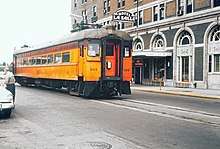
.jpg)
Pullman-Standard and the Standard Steel Car Company delivered electric multiple units to the CSS&SB between 1926–1929. Many were lengthened in the 1940s and 1950s.[19]
| Numbers | Model | Built | Builder | Notes |
|---|---|---|---|---|
| 1-11 | 62-seat coach | 1908 | Niles | Two cars scrapped prior to 1923; the remainder scrapped in 1929[20] |
| 12-15 | 62-seat coach | 1908 | Niles | Built as trailers. Rebuilt in 1915 with motors. Baggage compartments added in 1925. Scrapped in summer of 1929.[20] |
| 60-61 | 48-seat suburban car | 1908 | Kuhlman | 60 wrecked prior to 1918. 61 scrapped in 1927[20] |
| 62-63 | 44-seat suburban car | 1903 | Brill | Originally Chicago and Indiana Air Line Railway cars 1 and 2[20] |
| 64 | 48-seat suburban car | 1918 | Kuhlman | Built as a replacement for car 60[20] |
| 70-71 | 54-seat coach | 1908 | Niles | 71 rebuilt as CSS&SB 401 in 1927. 70 used as a yard office and scrapped in 1935.[20] |
| 72-74 | 46-seat combine | 1908 | Niles | Rebuilt with larger baggage compartments. 72 rebuilt to line car 1101 in 1927. 73 Rebuilt to work motor 1126 in 1927. 74 used as trainmen's room at South Bend and scrapped in 1941.[20] |
| 75-77 | 54-seat coach | 1908 | Niles | Scrapped in summer of 1929[20] |
| 101-110 | 52-seat coach | 1908 | Kuhlman | Two cars rebuilt into CSS&SB 222 and 224 in 1927. The remainder were scrapped in 1929.[20] |
| 111-112 | 60-seat open vestibule car | TBD | TBD | Purchased in 1917. Formerly AT&SF cars.[20] |
| 113-114 | 56-sear open vestibule car | TBD | TBD | Purchased in 1917. Formerly AT&SF cars.[20] |
| 1–10 | 56-seat coach smoker | 1926 | Pullman-Standard | |
| 11–15 | 80-seat coach | 1926 | Pullman-Standard | Lengthened in 1942–46 |
| 16–25 | 80-seat coach | 1927 | Pullman-Standard | Lengthened in 1945–47 |
| 26–29 | 80-seat coach | 1929 | Standard Steel | Lengthened in 1948 |
| 30–37; 39 | 48-seat coach smoker | 1929 | Standard Steel | |
| 38 | 56-seat coach | 1929 | Standard Steel | |
| 40 | 48-seat coach smoker | 1938 | Standard Steel | Rebuilt from trailer no. 213 |
| 100–109 | 64-68 seat coach-baggage | 1926 | Pullman-Standard | Lengthened in 1943–44 and modernized in 1949–50 |
| 110–111 | 64-seat coach-baggage | 1951 | Standard Steel | Rebuilt from coaches nos. 10 and 29 |
| 201–206 | 80-seat coach trailer | 1927 | Pullman-Standard | Lengthened in 1946–48 |
| 207–210 | 50-seat coach smoker trailer | 1927 | Pullman-Standard | |
| 211–212 | 50-seat coach smoker trailer | 1929 | Pullman-Standard | |
| 351-352 | 16-seat parlor-observation-buffet trailer | 1927 | Pullman Car & Manufacturing Co. | Originally 20 fixed chairs; rebuilt with 16 rotating chairs in 1929; rebuilt as coaches in 1942 |
| 353–354 | 56-seat coach trailer | 1938–39 | Standard Steel | Rebuilt from parlors built in 1929 |
Fare policies
The South Shore Line uses a zone-based fare system, with prices based on the distance traveled and stations' proximity to Millennium Station. There are a total of eleven zones (1–11). Tickets may be purchased at stations, online, and through the South Shore mobile app. Ticket options include one-way, 10-ride, 25-ride, and monthly passes. One-way tickets may also be purchased on trains, but will incur a $1.00 penalty fee if a ticket agent was present at the departure station. Children aged 13 years and under, seniors aged 65 and over, passengers with disabilities, students, active-duty military personnel, and those holding RTA Reduced Fare Permits are eligible for reduced fares. NICTD accepts cash aboard trains, cash and checks at ticket offices, and credit cards online and at Millennium Station's ticket office. Most stations have ticket machines which only accept credit cards.[21] For travel to Hegewisch station (zone 3), fares are set by Metra.[22]
Proposed expansions and realignments
Michigan City realignment

Since 2005, there has been an ongoing debate pertaining to plans to relocate trackage off the streets of Michigan City.[23] In July 2009, NICTD announced its intention to relocate the Michigan City track south of its current location in order to smooth out the curves, cut down the number of grade crossings, increase speed and reduce maintenance costs.[24] The plan also calls for the replacement of both current stations with a single new station located a block west of the current 11th Street boarding location (between Franklin and Washington streets) with a modern, high-level platform and parking lot. The plan would require a demolition of residential and retail buildings currently located on the south side of 11th Street.[25]
The relocation effort faced a setback in March 2010 when NICTD announced that it was short necessary funds to complete the preliminary engineering study. Unless the funding was found, the relocation would have been postponed indefinitely since, without the engineering study, NICTD would not be able to get state and federal funds necessary to complete the relocation.[26] NICTD and the city continued to work on obtaining the funds needed.[27] In 2011 NICTD accepted bids for a $1 million study, expected to take 18 months.[28] The study was completed in October 2013. The preferred alternative identified by the study preserves an alignment similar to the current route but relocates the tracks alongside the street. It proposes replacing the two existing stations with a new station near the center of Michigan City.[29] The realignment would done as a part of the double track project from Gary to Michigan City.[30]
Valparaiso branch
At a legislative hearing in October 2008, NICTD officials said they would drop further study of a Munster-to-Valparaiso route, and begin study of a Gary–Valparaiso route. At the hearing, NICTD officials said the projected cost of $673 million for the Munster-to-Valparaiso route as well as low projected ridership would have made it ineligible for federal funding and opted to study the Gary-to-Valparaiso route instead.[31] The Gary-to-Valparaiso route would utilize the partially abandoned former Pennsylvania Railroad line. NICTD officials contend the shorter length of a Gary-to-Valparaiso run and the chance to use existing tracks there may make it a lower-cost alternative to the Munster-to-Valparaiso route.
West Lake Corridor
West Lake Corridor | |||||||||||||||||||||||||||||||||||||||||||||||||||||||||||||||||||||||||||||||||||||||||||||||||||||||||||||||||||||||||
|---|---|---|---|---|---|---|---|---|---|---|---|---|---|---|---|---|---|---|---|---|---|---|---|---|---|---|---|---|---|---|---|---|---|---|---|---|---|---|---|---|---|---|---|---|---|---|---|---|---|---|---|---|---|---|---|---|---|---|---|---|---|---|---|---|---|---|---|---|---|---|---|---|---|---|---|---|---|---|---|---|---|---|---|---|---|---|---|---|---|---|---|---|---|---|---|---|---|---|---|---|---|---|---|---|---|---|---|---|---|---|---|---|---|---|---|---|---|---|---|---|---|
| |||||||||||||||||||||||||||||||||||||||||||||||||||||||||||||||||||||||||||||||||||||||||||||||||||||||||||||||||||||||||
Furthermore, NICTD planned to apply for federal funding for a preliminary engineering study and environmental survey of a Hammond-to-Lowell leg in 2009. As of 2008, that leg had a projected price tag of $551 million.[32] As of 2019, the cost has increased to $665 million. NICTD anticipates to be awarded funding in the spring of 2020 with construction beginning later in the year.[33] The project is estimated to open to revenue service in 2025.[34]
The new line will run to Dyer, with a later extension to St. John, and trains will run as shuttles between Hammond and Dyer during off-peak hours.[35] The alignment of the new branch leaves the old CSS&SB main immediately before the current Hammond station. Hence, the NICTD has decided to build a new station in Hammond to serve both branches.[36]
Station listing
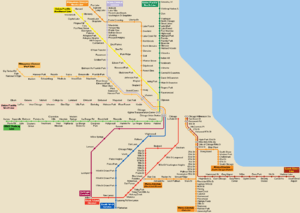
The line operates over the tracks of the Metra Electric Line from Millennium Station to Kensington-115th Street. Metra owns the track in this territory. Per a long-standing non-compete clause with Metra, outbound South Shore Line trains to Indiana only stop at Metra Electric stations to receive passengers; inbound trains to Millennium Station only stop at Metra Electric stations to discharge passengers.
South Shore Line trains make the following station stops:[37]
| State | Fare zone | Location | Station | Mile (km)[38] | Average weekday ridership (2015)[38] |
Connections and notes |
|---|---|---|---|---|---|---|
| IL | 1 | Chicago | Millennium Station | 0.0 (0) | 4,072 | Metra: Metra Electric District CTA Bus: 4, 6, 19, 20, 26, 60, N66, 124, 143, 147, 148, 151, 157 Chicago "L": Red, Brown, Green, Orange, Purple, Pink lines Pace: 855 ChicaGo Dash |
| Van Buren Street | 0.8 (1.3) | 1,431 | Metra: Metra Electric District CTA Bus: 1, 3, 4, 6, 7, J14, 26, 28, 126, 130, 147, 148, 151 | |||
| Museum Campus/11th Street | 1.4 (2.3) | 119 | Metra: Metra Electric District CTA Bus: 1, 3, 4, 12, 130, 146 | |||
| McCormick Place (weekend flag stop) |
2.7 (4.3) | 0 | Metra: Metra Electric District CTA Bus: 3, 21 | |||
| 53rd Street | 6.5 (10.5) | South Shore service withdrawn October 16, 1966, replaced by 57th Street | ||||
| 2 | 57th Street (Hyde Park) | 7.0 (11.3) | 234 | Metra: Metra Electric District CTA Bus: 15, 28, 55, 171 | ||
| 63rd Street (flag stop) |
7.9 (12.7) | 3 | Metra: Metra Electric District CTA Bus: 63 | |||
| Kensington - 115th Street | 14.5 (23.3) | South Shore service withdrawn February 15, 2012 | ||||
| 3 | Hegewisch | 19.0 (30.6) | 1,029 | CTA Bus: 30 Pace: 355, 358, 364 | ||
| IN | 4 | Hammond | Hammond | 20.9 (33.6) | 1,157 | |
| East Chicago | East Chicago | 23.4 (37.7) | 1,698 | East Chicago Transit: 1, 2, 4 | ||
| 5 | Gary | Gary/Chicago Airport (flag stop) |
28.0 (45.1) | 129 | GPTC: 12 | |
| Ambridge | Closed July 5, 1994 | |||||
| Gary Metro Center | 30.9 (49.7) | 412 | GPTC: 1, 6, 12, 13, 17, 18, 19, 22, 23 | |||
| Miller | 34.7 (55.8) | 463 | GPTC: 13 | |||
| 6 | Ogden Dunes | Portage/Ogden Dunes | 38.9 (62.6) | 234 | ||
| Dune Acres | Dune Acres | Closed 1994 | ||||
| Porter | Dune Park | 46.0 (74.0) | 520 | V-Line: Orange Line | ||
| Kemil Road | Closed July 5, 1994 | |||||
| 7 | Beverly Shores | Beverly Shores (flag stop) |
50.4 (81.1) | 33 | ||
| Michigan City | Willard Avenue | Closed July 5, 1994 | ||||
| 8 | 11th Street | 55.8 (89.8) | 83 | Michigan City Transit: 1, 2, 4 | ||
| Carroll Avenue | 57.5 (92.5) | 241 | Michigan City Transit: 3 | |||
| Smith | LaLumiere | Closed July 5, 1994 | ||||
| Rolling Prairie | Rolling Prairie | Closed July 5, 1994 | ||||
| 10 | Hudson Lake | Hudson Lake (flag stop) |
74.6 (120.1) | 5 | ||
| New Carlisle | New Carlisle | Closed July 5, 1994 | ||||
| 11 | South Bend | South Bend Airport | 90.1 (145.0) | 186 | Transpo: 4 Greyhound Lines Coach USA | |
| South Bend | Current Amtrak station, South Shore service withdrawn November 21, 1992 | |||||
| South Bend | Closed 1970, located in downtown South Bend |
Notes
- "TRANSIT RIDERSHIP REPORT - Second Quarter 2018" (PDF). APTA. American Public Transportation Association. Retrieved March 11, 2019.
- "TRANSIT RIDERSHIP REPORT - Fourth Quarter 2017" (PDF). APTA. American Public Transportation Association. Retrieved March 11, 2019.
- "Chicago South Shore and South Bend Railroad (NICTD)". southshore.railfan.net.
- Ogorek 2012, p. 9
- Middleton 1998, pp. 6–7
- Middleton 1998, p. 8
- Economic Adjustment Study: Chicago South Shore and South Bend Railroad Corridor, Final Report; Northwestern Indiana Regional Planning Commission and Northern Indiana Commuter Transportation District,; March 1980; pg 1
- "South Shore Line Switch Approved". Chicago Tribune. December 23, 1966. p. 2 Section 10.
- "Annual Report" (PDF). Northern Indiana Commuter Transportation District. December 31, 2010. p. 15. Archived from the original (PDF) on February 3, 2017. Retrieved January 31, 2017.
- Wieland, Phil (November 21, 1992). "New train terminal could have folks heading east, young". The Times of Northwest Indiana. Retrieved February 15, 2015.
- Dodson, Paul (June 17, 1994). "South Shore Railroad Will Close 7 Flagstops". South Bend Tribune. p. B2.
- "NICTD Board Meeting Minutes July 31, 2009" (PDF). Northern Indiana Commuter Transportation District. July 31, 2009. Archived from the original (PDF) on July 14, 2011. Retrieved September 11, 2010.
- Allen, Kevin (February 3, 2015). "Chicago express a major step for South Shore". South Bend Tribune. Retrieved February 15, 2015.
- "Detailed Line Map" (PDF). SouthShore.Railfan.net. February 2012. Retrieved May 24, 2016.
- Steele, Andrew (May 19, 2016). "Feds OK South Shore double-track project development". The Times of Northwest Indiana. Archived from the original on May 24, 2016. Retrieved May 24, 2016.
- "Electric Multiple Unit (EMU) for NICTD". Archived from the original on July 22, 2017. Retrieved July 23, 2017.
- "2013 Indiana Public Transit Annual Report" (PDF). Indiana Department of Transportation. August 2014. p. 111. Retrieved February 15, 2015.
- "Nippon Sharyo USA Product History". Archived from the original on June 26, 2017. Retrieved July 22, 2017.
- Randall, W. David (1974). Railway Passenger Car Annual, Volume I, 1973-1974. Park Forest, IL: RPC Publications. pp. 74–75.
- CERA 1960.
- "Purchase Tickets". South Shore Line. Retrieved August 10, 2020.
- "SSL Board Approves Fare Increase Effective July 1, 2018". South Shore Line. Retrieved August 10, 2020.
- Maddux, Stan (February 14, 2008). "Michigan City weighs South Shore track route". Post-Tribune. Retrieved February 18, 2008.
- South Shore re-route map
- Wink, Laurie (June 9, 2009). "More South Shore details released". The News Dispatch. Archived from the original on July 30, 2009. Retrieved August 22, 2009.
- Ebaugh, Alicia (March 25, 2010). "Funding dire for South Shore study". The News Dispatch. Retrieved March 26, 2010.
- Field, Matt (August 17, 2010). "City prepares to study South Shore routes". The News Dispatch. Retrieved August 19, 2010.
- Field, Matt (January 28, 2011). "Bids sought for NICTD study". The News Dispatch. Retrieved February 9, 2011.
- "Michigan City/NICTD Rail Realignment Study" (PDF).
- Steele, Andrew (February 11, 2020). "South Shore's Double Track project advances in federal grant process". The Times of Northwest Indiana. Retrieved February 16, 2020.
- Benman, Keith (December 17, 2008). "Study: Valpo route no good". The Times of Northwest Indiana. p. A1. Retrieved December 21, 2018 – via https://www.newspapers.com/.
- Benman, Keith (December 17, 2008). "Study: Valpo-to-Munster SS line would add few riders". The Times of Northwest Indiana. Retrieved September 1, 2009.
- "FTA gives favorable rating to proposed NICTD commuter-rail extension". Progressive Railroading. March 26, 2019. Retrieved March 26, 2019.
- Carden, Dan. "West Lake commuter rail line construction could begin in October". NWI Times. Retrieved July 18, 2020.
- Simón, Marisol R.; Noland, Michael; Federal Transit Administration; USDoT; US Army Corps of Engineers (December 2, 2016). West Lake Corridor Draft Environmental Impact Statement (Chapter 2: Alternatives Considered) (pdf) (Report). NICTD. Retrieved July 16, 2017.
- "Frequently Asked Questions". West Lake Corridor. 2017. Retrieved July 16, 2017.
- Economic Adjustment Study: Chicago South Shore and South Bend Railroad Corridor, Final Report; Northwestern Indiana Regional Planning Commission and Northern Indiana Commuter Transportation District; March 1980; Appendix A
- "2018 State of the System" (PDF). Metra. August 2018. p. 185.
References
- CERA (1960). Electric Railways of Indiana. Chicago, IL: Central Electric Railfans' Association. p. I-20.CS1 maint: ref=harv (link)
- Middleton, William D. (1970). South Shore: The Last Interurban. San Marino, CA: Golden West Books. ISBN 978-0870950032. OCLC 104029.
- Middleton, William D. (1999). South Shore: The Last Interurban : Revised Second Edition (Railroads Past and Present) (2nd ed.). Indiana University Press. ISBN 978-0253335333.
- Middleton, William D. (1998). "Insull's Super-Interurban". In Cohen, Ronald D.; McShane, Stephen G. (eds.). Moonlight in Duneland: The Illustrated Story of the Chicago South Shore and South Bend Railroad. Indiana University Press. ISBN 0-253-33418-7. OCLC 38862554.CS1 maint: ref=harv (link)
- Ogorek, Cynthia L. (2012). Along the Chicago South Shore & South Bend Rail Line. Images of America. Charleston, South Carolina: Arcadia Publishing. ISBN 978-0-738-59419-4.CS1 maint: ref=harv (link)
- SouthShore.Railfan.net. "Chicago South Shore and South Bend Railroad (NICTD)". southshore.railfan.net.CS1 maint: ref=harv (link)
- Van Hattem, Matt (July 5, 2006). "South Shore Line - The commuter railroad linking Chicago and South Bend, Ind". Trains.
External links
| Wikimedia Commons has media related to South Shore Line. |
